名词解释
- 格式:doc
- 大小:132.50 KB
- 文档页数:8
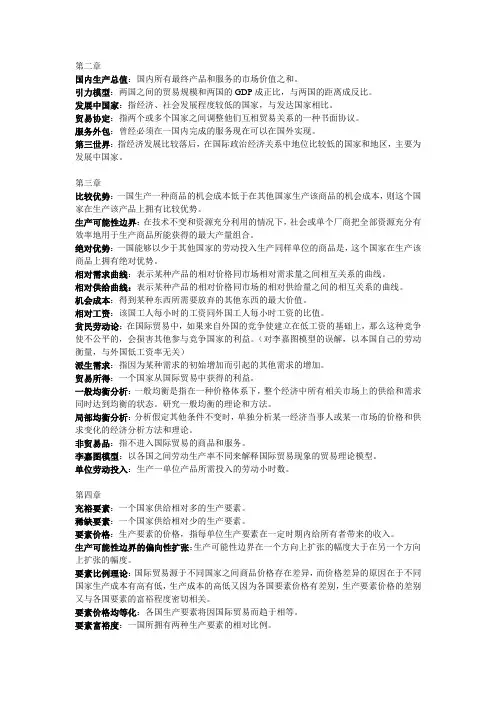
第二章国内生产总值:国内所有最终产品和服务的市场价值之和。
引力模型:两国之间的贸易规模和两国的GDP成正比,与两国的距离成反比。
发展中国家:指经济、社会发展程度较低的国家,与发达国家相比。
贸易协定:指两个或多个国家之间调整他们互相贸易关系的一种书面协议。
服务外包:曾经必须在一国内完成的服务现在可以在国外实现。
第三世界:指经济发展比较落后,在国际政治经济关系中地位比较低的国家和地区,主要为发展中国家。
第三章比较优势:一国生产一种商品的机会成本低于在其他国家生产该商品的机会成本,则这个国家在生产该产品上拥有比较优势。
生产可能性边界:在技术不变和资源充分利用的情况下,社会或单个厂商把全部资源充分有效率地用于生产商品所能获得的最大产量组合。
绝对优势:一国能够以少于其他国家的劳动投入生产同样单位的商品是,这个国家在生产该商品上拥有绝对优势。
相对需求曲线:表示某种产品的相对价格同市场相对需求量之间相互关系的曲线。
相对供给曲线:表示某种产品的相对价格同市场的相对供给量之间的相互关系的曲线。
机会成本:得到某种东西所需要放弃的其他东西的最大价值。
相对工资:该国工人每小时的工资同外国工人每小时工资的比值。
贫民劳动论:在国际贸易中,如果来自外国的竞争使建立在低工资的基础上,那么这种竞争使不公平的,会损害其他参与竞争国家的利益。
(对李嘉图模型的误解,以本国自己的劳动衡量,与外国低工资率无关)派生需求:指因为某种需求的初始增加而引起的其他需求的增加。
贸易所得:一个国家从国际贸易中获得的利益。
一般均衡分析:一般均衡是指在一种价格体系下,整个经济中所有相关市场上的供给和需求同时达到均衡的状态。
研究一般均衡的理论和方法。
局部均衡分析:分析假定其他条件不变时,单独分析某一经济当事人或某一市场的价格和供求变化的经济分析方法和理论。
非贸易品:指不进入国际贸易的商品和服务。
李嘉图模型:以各国之间劳动生产率不同来解释国际贸易现象的贸易理论模型。
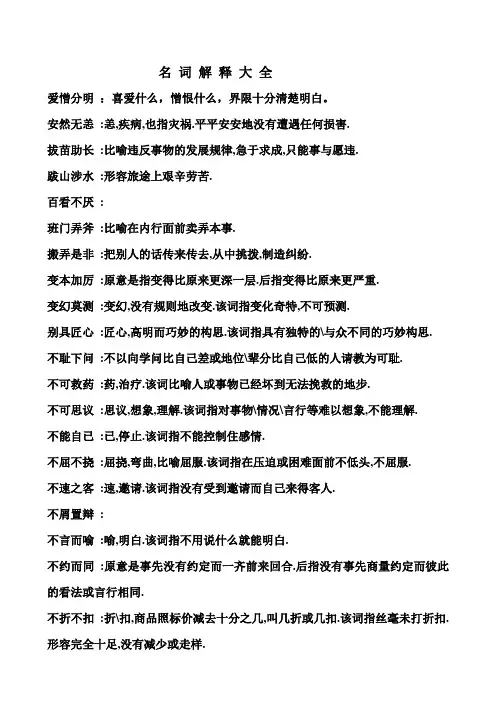
名词解释大全爱憎分明:喜爱什么,憎恨什么,界限十分清楚明白。
安然无恙:恙,疾病,也指灾祸.平平安安地没有遭遇任何损害.拔苗助长:比喻违反事物的发展规律,急于求成,只能事与愿违.跋山涉水:形容旅途上艰辛劳苦.百看不厌:班门弄斧:比喻在内行面前卖弄本事.搬弄是非:把别人的话传来传去,从中挑拨,制造纠纷.变本加厉:原意是指变得比原来更深一层.后指变得比原来更严重.变幻莫测:变幻,没有规则地改变.该词指变化奇特,不可预测.别具匠心:匠心,高明而巧妙的构思.该词指具有独特的\与众不同的巧妙构思.不耻下问:不以向学问比自己差或地位\辈分比自己低的人请教为可耻.不可救药:药,治疗.该词比喻人或事物已经坏到无法挽救的地步.不可思议:思议,想象,理解.该词指对事物\情况\言行等难以想象,不能理解.不能自已:已,停止.该词指不能控制住感情.不屈不挠:屈挠,弯曲,比喻屈服.该词指在压迫或困难面前不低头,不屈服.不速之客:速,邀请.该词指没有受到邀请而自己来得客人.不屑置辩:不言而喻:喻,明白.该词指不用说什么就能明白.不约而同:原意是事先没有约定而一齐前来回合.后指没有事先商量约定而彼此的看法或言行相同.不折不扣:折\扣,商品照标价减去十分之几,叫几折或几扣.该词指丝毫未打折扣.形容完全十足,没有减少或走样.畅所欲言:畅,尽情\痛快.该词指痛痛快快地把要说的话都说出来.车水马龙:车像流水,马如游龙.形容车马来来往往的热闹景象.称心如意:称,适合.如,符合.该词指完全合乎心意.承前启后:承,接续.启,开创.该词指承接前代的,开创以后的.多用于事业\学术等领域.诚心诚意:诚,真实\诚恳.该词指真挚诚恳.触景生情:触,触动.该词指被眼前景物所触动而产生了某种感情.触目惊心:触目,目光接触到的.该词指看到的情况,引起内心震惊..穿凿附会:穿凿,勉强进行解释。
附会,将毫无关系的事物生硬地联系在一起。
该词指在论争中勉强解释、生硬联系。
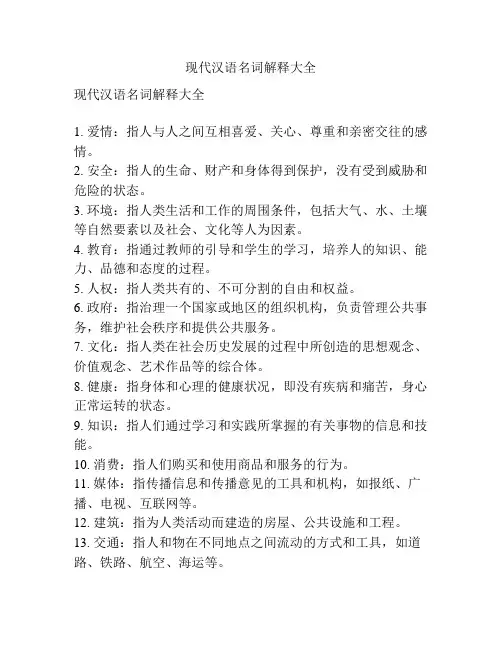
现代汉语名词解释大全现代汉语名词解释大全1. 爱情:指人与人之间互相喜爱、关心、尊重和亲密交往的感情。
2. 安全:指人的生命、财产和身体得到保护,没有受到威胁和危险的状态。
3. 环境:指人类生活和工作的周围条件,包括大气、水、土壤等自然要素以及社会、文化等人为因素。
4. 教育:指通过教师的引导和学生的学习,培养人的知识、能力、品德和态度的过程。
5. 人权:指人类共有的、不可分割的自由和权益。
6. 政府:指治理一个国家或地区的组织机构,负责管理公共事务,维护社会秩序和提供公共服务。
7. 文化:指人类在社会历史发展的过程中所创造的思想观念、价值观念、艺术作品等的综合体。
8. 健康:指身体和心理的健康状况,即没有疾病和痛苦,身心正常运转的状态。
9. 知识:指人们通过学习和实践所掌握的有关事物的信息和技能。
10. 消费:指人们购买和使用商品和服务的行为。
11. 媒体:指传播信息和传播意见的工具和机构,如报纸、广播、电视、互联网等。
12. 建筑:指为人类活动而建造的房屋、公共设施和工程。
13. 交通:指人和物在不同地点之间流动的方式和工具,如道路、铁路、航空、海运等。
14. 科技:指科学和技术的结合体,包括科学研究、技术开发和应用。
15. 文学:指用语言来表达思想、感情和意境的艺术形式。
16. 历史:指过去发生的事件、人物和事物的纪录和研究。
17. 经济:指社会生产、分配、交换和消费的一系列活动。
18. 政治:指社会组织和管理权力的活动和制度。
19. 心理:指人的思维、情感、意识等心理过程和状态。
20. 卫生:指人的健康保健和疾病预防的措施和活动。
21. 军事:指国家用来维护国家安全和利益的武装力量和战争活动。
22. 农业:指种植农作物和养殖家畜的生产活动。
23. 玩具:指供儿童玩耍和学习的物品。
24. 电影:指用电影摄影技术制作的艺术作品。
25. 社会:指人类的群体组织和关系,以及人们在其中生活和互动的活动。

名词解释一、名词解释1、真种子:植物学上所定义的种子,整个籽粒由胚珠发育而成.2、农业种子:农业种子:在农业生产上,种子泛指播种材料,即凡是由于播种的植物器官,统称为.3、种脐:是种子成熟后从种柄上脱落时留下的疤痕,或说是种子附着在胎座上的部位,是种子发育过程中营养物质从母体流入子体的通道.4、发芽口:又称种孔是胚珠时期珠孔的遗迹5、脐条:又称种脊种脉,是倒生,半倒生胚珠从珠柄通道合点的维管束遗迹.6、内脐:是胚珠时期合点的遗迹,位于脐条的终点部位,稍呈突起状.7、种子寿命:8、外胚乳9、内胚乳10、糊粉层11、种子活力:种子活力:指决定种子和种子批在发芽和出苗期间活性强度及该种子特征的综合表现。
12、盾片13、自由水14、束缚水15、无胚现象16、多胚现象17、无性种子18、临界水分19、安全水分:能够保证种子安全储藏的种子含水量范围。
20、平衡水分21、酸价22、碘价22、碘价23、油质酸败:油质或油质种子保管不当或贮藏过久,会产生一些醛,酮,酸类物质,从而产生不良气味,称~~~~。
24、种子败育25、种子休眠26、硬实27、种子休眠期:从种子收获到发芽率达到80%所经历的时间.29、种子生活力30、种子活力31、种子劣变32、发芽指数(GI)33、活力指数(VI)34、种子寿命35、种子萌发36、种子容重37、种子比重38、种子千粒重39、种子堆孔隙度40、种子堆密度41、静止角42、自流角44、种子干燥曲线45、种子发热46、种子结露47、种子加工48、种子包衣与丸化50、种子自动分级51、扦样52、初次样品53、混合样品54、送验样品55、种子净度56、品种纯度: 本品种粒数占检验总粒数的百分数.57、发芽势58、发芽率59、种子水分60、人工种子:指通过组织培养获得发育完全的植物个体,将其用适当方法加以保护,以代替天然种子传播的结构。
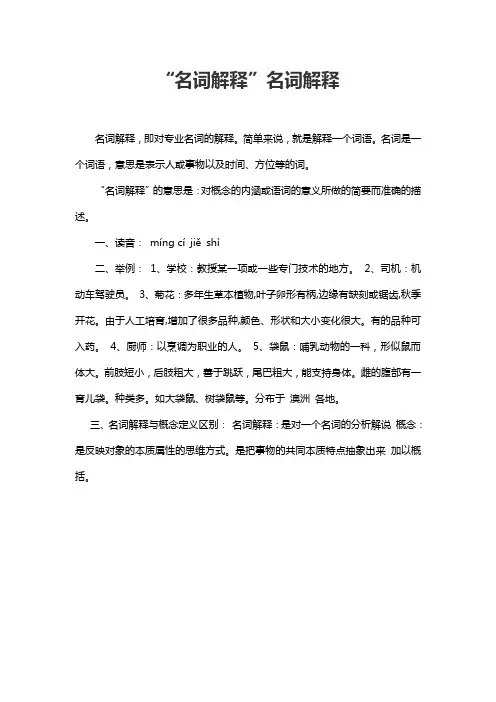
“名词解释”名词解释
名词解释,即对专业名词的解释。
简单来说,就是解释一个词语。
名词是一个词语,意思是表示人或事物以及时间、方位等的词。
“名词解释”的意思是:对概念的内涵或语词的意义所做的简要而准确的描述。
一、读音:míng cíjiěshì
二、举例:1、学校:教授某一项或一些专门技术的地方。
2、司机:机动车驾驶员。
3、菊花:多年生草本植物,叶子卵形有柄,边缘有缺刻或锯齿,秋季开花。
由于人工培育,增加了很多品种,颜色、形状和大小变化很大。
有的品种可入药。
4、厨师:以烹调为职业的人。
5、袋鼠:哺乳动物的一科,形似鼠而体大。
前肢短小,后肢粗大,善于跳跃,尾巴粗大,能支持身体。
雌的腹部有一育儿袋。
种类多。
如大袋鼠、树袋鼠等。
分布于澳洲各地。
三、名词解释与概念定义区别:名词解释:是对一个名词的分析解说概念:是反映对象的本质属性的思维方式。
是把事物的共同本质特点抽象出来加以概括。
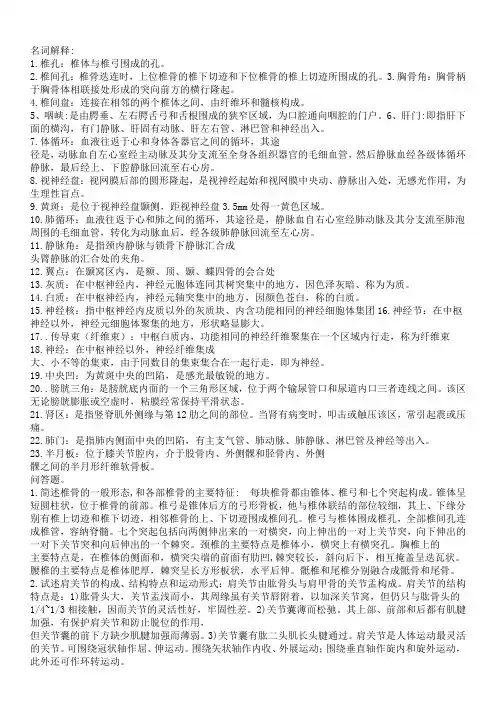
名词解释:1.椎孔:椎体与椎弓围成的孔。
2.椎间孔:椎骨迭连时,上位椎骨的椎下切迹和下位椎骨的椎上切迹所围成的孔。
3.胸骨角:胸骨柄于胸骨体相联接处形成的突向前方的横行隆起。
4.椎间盘:连接在相邻的两个椎体之间,由纤维环和髓核构成。
5、咽峡:是由腭垂、左右腭舌弓和舌根围成的狭窄区域,为口腔通向咽腔的门户。
6、肝门:即指肝下面的横沟,有门静脉、肝固有动脉、肝左右管、淋巴管和神经出入。
7.体循环:血液往返于心和身体各器官之间的循环,其途径是,动脉血自左心室经主动脉及其分支流至全身各组织器官的毛细血管,然后静脉血经各级体循环静脉,最后经上、下腔静脉回流至右心房。
8.视神经盘:视网膜后部的圆形隆起,是视神经起始和视网膜中央动、静脉出入处,无感光作用,为生理性盲点。
9.黄斑:是位于视神经盘颞侧,距视神经盘3.5mm处得一黄色区域。
10.肺循环:血液往返于心和肺之间的循环,其途径是,静脉血自右心室经肺动脉及其分支流至肺泡周围的毛细血管,转化为动脉血后,经各级肺静脉回流至左心房。
11.静脉角:是指颈内静脉与锁骨下静脉汇合成头臂静脉的汇合处的夹角。
12.翼点:在颞窝区内,是额、顶、颞、蝶四骨的会合处13.灰质:在中枢神经内,神经元胞体连同其树突集中的地方,因色泽灰暗、称为为质。
14.白质:在中枢神经内,神经元轴突集中的地方,因颜色苍白,称的白质。
15.神经核:指中枢神经内皮质以外的灰质块、内含功能相同的神经细胞体集团16.神经节:在中枢神经以外,神经元细胞体聚集的地方,形状略显膨大。
17..传导束(纤维束):中枢白质内,功能相同的神经纤维聚集在一个区域内行走,称为纤维束18.神经:在中枢神经以外,神经纤维集成大、小不等的集束,由于同数目的集束集合在一起行走,即为神经。
19.中央凹:为黄斑中央的凹陷,是感光最敏锐的地方。
20..膀胱三角:是膀胱底内面的一个三角形区域,位于两个输尿管口和尿道内口三者连线之间。
该区无论膀胱膨胀或空虚时,粘膜经常保持平滑状态。
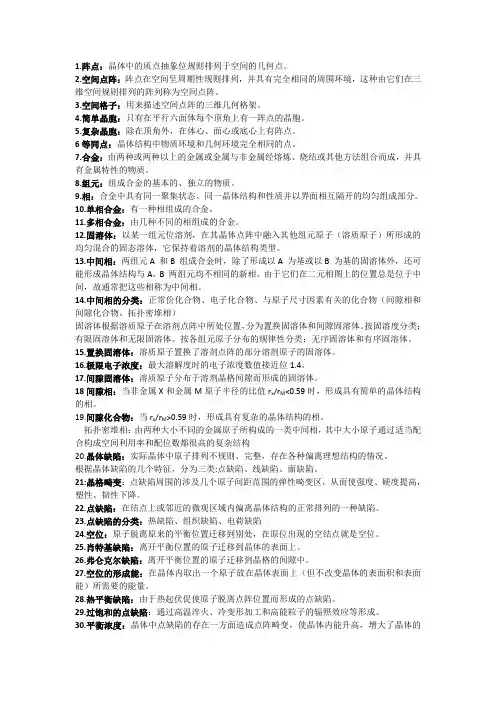
1.阵点:晶体中的质点抽象位规则排列于空间的几何点。
2.空间点阵:阵点在空间呈周期性规则排列,并具有完全相同的周围环境,这种由它们在三维空间规则排列的阵列称为空间点阵。
3.空间格子:用来描述空间点阵的三维几何格架。
4.简单晶胞:只有在平行六面体每个顶角上有一阵点的晶胞。
5.复杂晶胞:除在顶角外,在体心、面心或底心上有阵点。
6等同点:晶体结构中物质环境和几何环境完全相同的点。
7.合金:由两种或两种以上的金属或金属与非金属经熔炼、烧结或其他方法组合而成,并具有金属特性的物质。
8.组元:组成合金的基本的、独立的物质。
9.相:合金中具有同一聚集状态、同一晶体结构和性质并以界面相互隔开的均匀组成部分。
10.单相合金:有一种相组成的合金。
11.多相合金:由几种不同的相组成的合金。
12.固溶体:以某一组元位溶剂,在其晶体点阵中融入其他组元原子(溶质原子)所形成的均匀混合的固态溶体,它保持着溶剂的晶体结构类型。
13.中间相:两组元A 和B 组成合金时,除了形成以A 为基或以B 为基的固溶体外,还可能形成晶体结构与A,B 两组元均不相同的新相。
由于它们在二元相图上的位置总是位于中间,故通常把这些相称为中间相。
14.中间相的分类:正常价化合物、电子化合物、与原子尺寸因素有关的化合物(间隙相和间隙化合物、拓扑密堆相)固溶体根据溶质原子在溶剂点阵中所处位置,分为置换固溶体和间隙固溶体。
按固溶度分类:有限固溶体和无限固溶体。
按各组元原子分布的规律性分类:无序固溶体和有序固溶体。
15.置换固溶体:溶质原子置换了溶剂点阵的部分溶剂原子的固溶体。
16.极限电子浓度:最大溶解度时的电子浓度数值接近位1.4。
17.间隙固溶体:溶质原子分布于溶剂晶格间隙而形成的固溶体。
18间隙相:当非金属X和金属M原子半径的比值r x/r M<0.59时,形成具有简单的晶体结构的相。
19.间隙化合物:当r x/r M>0.59时,形成具有复杂的晶体结构的相。
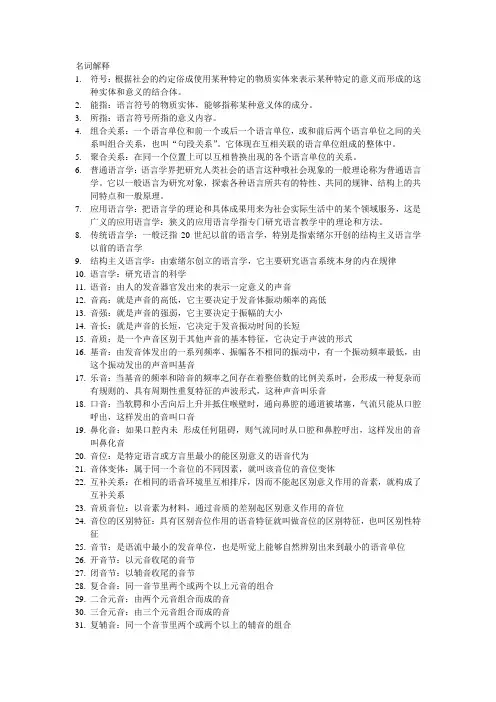
名词解释1.符号:根据社会的约定俗成使用某种特定的物质实体来表示某种特定的意义而形成的这种实体和意义的结合体。
2.能指:语言符号的物质实体,能够指称某种意义体的成分。
3.所指:语言符号所指的意义内容。
4.组合关系:一个语言单位和前一个或后一个语言单位,或和前后两个语言单位之间的关系叫组合关系,也叫“句段关系”。
它体现在互相关联的语言单位组成的整体中。
5.聚合关系:在同一个位置上可以互相替换出现的各个语言单位的关系。
6.普通语言学:语言学界把研究人类社会的语言这种哦社会现象的一般理论称为普通语言学。
它以一般语言为研究对象,探索各种语言所共有的特性、共同的规律、结构上的共同特点和一般原理。
7.应用语言学:把语言学的理论和具体成果用来为社会实际生活中的某个领域服务,这是广义的应用语言学:狭义的应用语言学指专门研究语言教学中的理论和方法。
8.传统语言学:一般泛指20世纪以前的语言学,特别是指索绪尔开创的结构主义语言学以前的语言学9.结构主义语言学:由索绪尔创立的语言学,它主要研究语言系统本身的内在规律10.语言学:研究语言的科学11.语音:由人的发音器官发出来的表示一定意义的声音12.音高:就是声音的高低,它主要决定于发音体振动频率的高低13.音强:就是声音的强弱,它主要决定于振幅的大小14.音长:就是声音的长短,它决定于发音振动时间的长短15.音质:是一个声音区别于其他声音的基本特征,它决定于声波的形式16.基音:由发音体发出的一系列频率、振幅各不相同的振动中,有一个振动频率最低,由这个振动发出的声音叫基音17.乐音:当基音的频率和陪音的频率之间存在着整倍数的比例关系时,会形成一种复杂而有规则的、具有周期性重复特征的声波形式,这种声音叫乐音18.口音:当软腭和小舌向后上升并抵住喉壁时,通向鼻腔的通道被堵塞,气流只能从口腔呼出,这样发出的音叫口音19.鼻化音:如果口腔内未形成任何阻碍,则气流同时从口腔和鼻腔呼出,这样发出的音叫鼻化音20.音位:是特定语言或方言里最小的能区别意义的语音代为21.音体变体:属于同一个音位的不同因素,就叫该音位的音位变体22.互补关系:在相同的语音环境里互相排斥,因而不能起区别意义作用的音素,就构成了互补关系23.音质音位:以音素为材料,通过音质的差别起区别意义作用的音位24.音位的区别特征:具有区别音位作用的语音特征就叫做音位的区别特征,也叫区别性特征25.音节:是语流中最小的发音单位,也是听觉上能够自然辨别出来到最小的语音单位26.开音节:以元音收尾的音节27.闭音节:以辅音收尾的音节28.复合音:同一音节里两个或两个以上元音的组合29.二合元音:由两个元音组合而成的音30.三合元音:由三个元音组合而成的音31.复辅音:同一个音节里两个或两个以上的辅音的组合32.撮口呼音节:以韵母{y}为韵头或韵腹的音节叫撮口呼音节33.音渡:语音单元在前后过渡、相互连接时,会因为自身性质的不同而采取不同的过渡和连接方式,这些方式叫做“音渡”,也叫“音联”34.语流音变:在连续的语流中,一个可能由于邻近音的影响,或自身所处地位的不同,或说话的快慢、高低、强弱的不同而在发音上产生一些变化,这种现象叫语流音变35.韵律特征:韵律特征又叫做“超音质特征”或“超音段特征”指的是语音中除音质特征之外的音高、音长和音强方面的变化36.时位:长短音也可以像元辅音音位那样区别意义的作用,所以也可以把它们看做是一种音位,这种非音质音位叫做“时位”37.调值:反映声调音高的变化形式和变化幅度的线段或数字38.调类:一种语言或方言中声调的类别39.固定重音:如果不同词里的重音都落在词的同一位置上,这种词重音就叫固定重音40.语调:与全句的意思以及说话人的情感、态度相关的全句的高低、长短、强弱等方面的变化41.语汇:语汇指一种语言中词语的总和,是一个特定的集合概念42.基本语汇:是整个语汇系统的基础核心,它具有产生的历史长,使用的范围广和构词的能力强三大特点43.一般语汇:语汇中除去基本语汇以外的那一部分,它包括古语词、方言词、外来词、新造词等44.惯用语:指表达习惯性比喻含义的固定词组,多为三个字45.成语:是汉语特有的而且最大使用的熟语形式,一般四个字46.谚语:指在民间流传的通俗语句47.歇后语:是汉语的一种特殊熟语形式,指一种短小风趣、生动形象的语句,有两部分组成,一般只说上半句,下半句略去,利用谐音或比喻双关来表达某种意义48.变性成词:指语素转变性而形成另一类词。
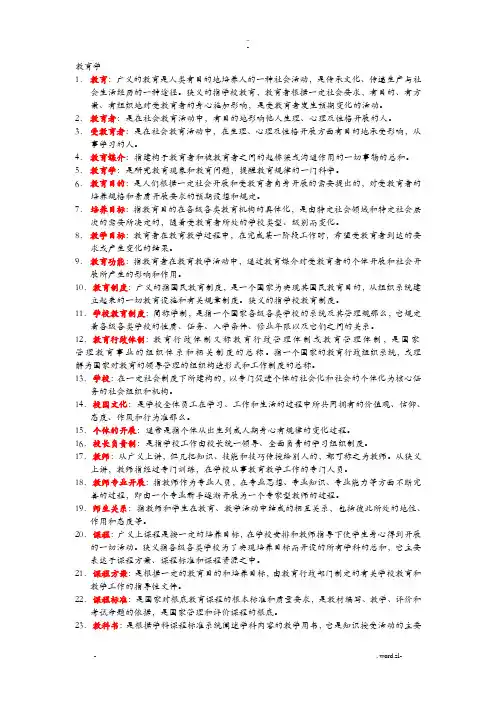
教育学1.教育:广义的教育是人类有目的地培养人的一种社会活动,是传承文化、传递生产与社会生活经历的一种途径。
狭义的指学校教育,教育者根据一定社会要求,有目的、有方案、有组织地对受教育者的身心施加影响,是受教育者发生预期变化的活动。
2.教育者:是在社会教育活动中,有目的地影响他人生理、心理及性格开展的人。
3.受教育者:是在社会教育活动中,在生理、心理及性格开展方面有目的地承受影响,从事学习的人。
4.教育媒介:指建构于教育者和被教育者之间的起桥梁或沟通作用的一切事物的总和。
5.教育学:是研究教育现象和教育问题,提醒教育规律的一门科学。
6.教育目的:是人们根据一定社会开展和受教育者自身开展的需要提出的,对受教育者的培养规格和素质开展要求的预期设想和规定。
7.培养目标:指教育目的在各级各类教育机构的具体化,是由特定社会领域和特定社会层次的需要所决定的,随着受教育者所处的学校类型、级别而变化。
8.教学目标:教育者在教育教学过程中,在完成某一阶段工作时,希望受教育者到达的要求或产生变化的结果。
9.教育功能:指教育者在教育教学活动中,通过教育媒介对受教育者的个体开展和社会开展所产生的影响和作用。
10.教育制度:广义的指国民教育制度,是一个国家为实现其国民教育目的,从组织系统建立起来的一切教育设施和有关规章制度。
狭义的指学校教育制度。
11.学校教育制度:简称学制,是指一个国家各级各类学校的系统及其管理规那么,它规定着各级各类学校的性质、任务、入学条件、修业年限以及它们之间的关系。
12.教育行政体制:教育行政体制又称教育行政管理体制或教育管理体制,是国家管理教育事业的组织体系和相关制度的总称。
指一个国家的教育行政组织系统,或理解为国家对教育的领导管理的组织构造形式和工作制度的总称。
13.学校:在一定社会制度下所建构的,以专门促进个体的社会化和社会的个体化为核心任务的社会组织和机构。
14.校园文化:是学校全体员工在学习、工作和生活的过程中所共同拥有的价值观、信仰、态度、作风和行为准那么。
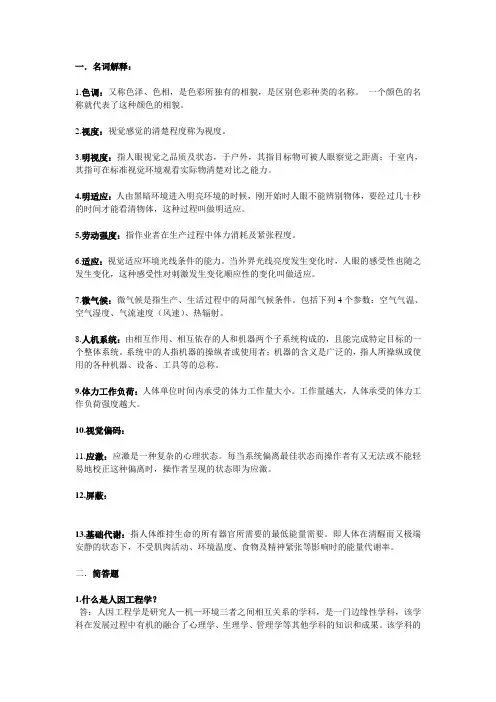
一.名词解释:1.色调:又称色泽、色相,是色彩所独有的相貌,是区别色彩种类的名称。
一个颜色的名称就代表了这种颜色的相貌。
2.视度:视觉感觉的清楚程度称为视度。
3.明视度:指人眼视觉之品质及状态,于户外,其指目标物可被人眼察觉之距离;于室内,其指可在标准视觉环境观看实际物清楚对比之能力。
4.明适应:人由黑暗环境进入明亮环境的时候,刚开始时人眼不能辨别物体,要经过几十秒的时间才能看清物体,这种过程叫做明适应。
5.劳动强度:指作业者在生产过程中体力消耗及紧张程度。
6.适应:视觉适应环境光线条件的能力。
当外界光线亮度发生变化时,人眼的感受性也随之发生变化,这种感受性对刺激发生变化顺应性的变化叫做适应。
7.微气候:微气候是指生产、生活过程中的局部气候条件。
包括下列4个参数:空气气温、空气湿度、气流速度(风速)、热辐射。
8.人机系统:由相互作用、相互依存的人和机器两个子系统构成的,且能完成特定目标的一个整体系统。
系统中的人指机器的操纵者或使用者;机器的含义是广泛的,指人所操纵或使用的各种机器、设备、工具等的总称。
9.体力工作负荷:人体单位时间内承受的体力工作量大小。
工作量越大,人体承受的体力工作负荷强度越大。
10.视觉偏码:11.应激:应激是一种复杂的心理状态。
每当系统偏离最佳状态而操作者有又无法或不能轻易地校正这种偏离时,操作者呈现的状态即为应激。
12.屏蔽:13.基础代谢:指人体维持生命的所有器官所需要的最低能量需要。
即人体在清醒而又极端安静的状态下,不受肌肉活动、环境温度、食物及精神紧张等影响时的能量代谢率。
二.简答题1.什么是人因工程学?答:人因工程学是研究人—机—环境三者之间相互关系的学科,是一门边缘性学科,该学科在发展过程中有机的融合了心理学、生理学、管理学等其他学科的知识和成果。
该学科的研究目的在于设计和改进人—机—环境系统,使系统获得较高的效率和效益,同时保证人的安全、健康和舒适。
综上所诉,人因工程学即按照人的特性设计和改进人—机—环境系统的科学。
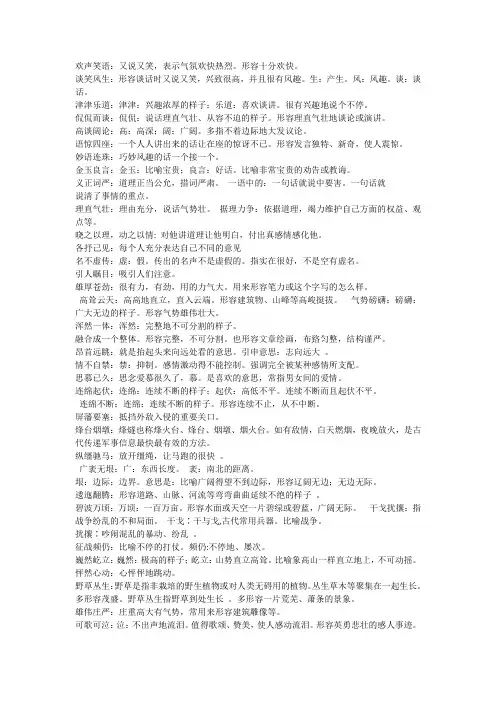
欢声笑语:又说又笑,表示气氛欢快热烈。
形容十分欢快。
谈笑风生:形容谈话时又说又笑,兴致很高,并且很有风趣。
生:产生。
风:风趣。
谈:谈话。
津津乐道:津津:兴趣浓厚的样子;乐道:喜欢谈讲。
很有兴趣地说个不停。
侃侃而谈:侃侃:说话理直气壮、从容不迫的样子。
形容理直气壮地谈论或演讲。
高谈阔论:高:高深;阔:广阔。
多指不着边际地大发议论。
语惊四座:一个人人讲出来的话让在座的惊讶不已。
形容发言独特、新奇,使人震惊。
妙语连珠:巧妙风趣的话一个接一个。
金玉良言:金玉:比喻宝贵;良言:好话。
比喻非常宝贵的劝告或教诲。
义正词严:道理正当公允,措词严肃。
一语中的:一句话就说中要害。
一句话就说清了事情的重点。
理直气壮:理由充分,说话气势壮。
据理力争:依据道理,竭力维护自己方面的权益、观点等。
晓之以理,动之以情: 对他讲道理让他明白,付出真感情感化他。
各抒己见:每个人充分表达自己不同的意见名不虚传:虚:假。
传出的名声不是虚假的。
指实在很好,不是空有虚名。
引人瞩目:吸引人们注意。
雄厚苍劲:很有力,有劲,用的力气大。
用来形容笔力或这个字写的怎么样。
高耸云天:高高地直立,直入云端。
形容建筑物、山峰等高峻挺拔。
气势磅礴:磅礴:广大无边的样子。
形容气势雄伟壮大。
浑然一体:浑然:完整地不可分割的样子。
融合成一个整体。
形容完整,不可分割。
也形容文章绘画,布臵匀整,结构谨严。
昂首远眺:就是抬起头来向远处看的意思。
引申意思:志向远大。
情不自禁:禁:抑制。
感情激动得不能控制。
强调完全被某种感情所支配。
思慕已久:思念爱慕很久了,慕。
是喜欢的意思,常指男女间的爱情。
连绵起伏:连绵:连续不断的样子;起伏:高低不平。
连续不断而且起伏不平。
连绵不断:连绵:连续不断的样子。
形容连续不止,从不中断。
屏藩要塞:抵挡外敌入侵的重要关口。
烽台烟墩:烽燧也称烽火台、烽台、烟墩、烟火台。
如有敌情,白天燃烟,夜晚放火,是古代传递军事信息最快最有效的方法。
纵缰驰马:放开缰绳,让马跑的很快。
名词解释1.外来化学物质,指即非人体组成成分,也不是人体所需营养物质,而是存在于外环境中,可通过一定环节和途径与机体接触,并呈现一定生物学作用的化学物质2.安全性:指一种外来化学物质在规定的使用方式和用量条件下,对人体健康不致产生任何损害,即不引起急性、慢性中毒,亦不对接触者(包括老、弱、病、幼、孕妇)及其后代产生潜在危害。
3.危险度:指一种外来化学物质在具体的接触条件下,对机体造成损害可能性的定量估计。
4.最大无作用剂量:指根据目前的认识水平,用最灵敏的方法和观察指标,未能观察到对机体任何损害作用的最高剂量。
有的文献中也称为未观察到作用的剂量或未观察到效应的水平(NOEL)。
5.最小有作用剂量:即在一定时间内,一种外来化合物按一定方式或途径与机体接触,能使某项观察指标开始出现异常变化或使机体开始出现损害作用所需的最低剂量。
6.实验动物(Lboratory Animal)是指经人工饲育,对其携带微生物实行控制,遗传背景明确或来源清楚的,用于科学研究、教学、生产、检定以及其它科学试验的动物。
7.半数致死量(LD50):指能引起一组实验动物中死亡一半的剂量。
也称致死中量。
8.急性毒作用带:指化合物的毒性上限与毒性下限的比值,也就是引起试验动物的死亡之剂量与最低剂量的剂量范围的宽窄。
9.蓄积系数:将能够达到同一效应(如ED50或LD50)分次给予机体所需外来化合物总剂量(以LD50(n)表示)与一次给予所需剂量(以LD50(1)表示)之比作为蓄积系数(K),来表示一种化学物质蓄积性的大小。
10.蓄积率=((对照群LD50)—(蓄积群LD50)/ (蓄积期间给予蓄积群动物被检物总剂量)11.微核是由于某些物理或化学因素的作用,使细胞内染色体断裂产生无着丝点断片或纺锤体受影响而在有丝分裂时,使遗传物质滞留在核外而产生的细胞中主核之外的遗传物质的颗粒,染色与细胞核一致,大小相当于细胞直径的1/20~1/5。
名词解释:1.教育者:凡是对受教育者在知识、技能、思想、品德等方面起到教育影响作用的人,都可称为教育者。
2.受教育者:在各种教育活动中从事学习的人,既包括学习中学习的儿童、少年和青年,也包括各种教育形式的成人学生。
3.教育:是一种有目的的培养人的社会活动。
4.教育中介系统:是教育者与受教育者联系与互动的纽带,是开展教育活动的内容和方式。
5.教育内容:是教育者用来作用于受教育者的影响物,它是根据教育目的,经过挑选和加工的、最有教育价值和适合受教育者身心发展水平的人类科学文化成果的结晶。
6.人的发展史两种释义:一种是人类的发展与进化;另一种是把它与个体发展利息起来,把它看成是人类个体的成长变化过程。
7.广义的个体发展:个人从胚胎到死亡的变化过程,其发展持续与人的一生。
8.狭义的个体发展:个人从出生到成人的变化过程,主要是指儿童的发展,儿童的发展过程也就是儿童的成人过程。
这既是由自然人向社会人,婴幼儿向成年人,个人小我向放眼世界、胸怀群体以及人类的大我的转化过程,也是不确定性与确定性、可能性与选择性、共性个性相统一的发展过程。
9.遗传:指人从上代继承下来的生理解剖上的特点,如机体的结构、形态、感官和神经系统的特点及本能、天赋倾向等。
这些遗传的生理特点,也叫遗传素质,是人的发展的自然的或生理的前提条件。
10.环境:指个体生存于其中,在个体的活动交往中,与个体相互作用并影响个体发展的外部世界。
可分为自然环境与社会环境两大类。
11.环境给定性:指由自然、历史,由前人、他人为儿童个体所创造的环境,它对于儿童来说是客观的、先在的、给定的。
12.教育的社会变迁功能:指教育通过开发人的潜能、提高人的素质、促进人的社会化,引导人的社会实践,不仅能够使人适应社会的发展,而且能够推动社会的改革与发展。
13.政治社会化:指引导人们接受一定的社会政治意识形态,形成适应于一定社会政治制度的政治态度与政治认同感,以及积极参与政治、监督政治的政治习惯与能力的过程。
一、名词解释1、发育生物学:是应用现代生物学技术研究多细胞生物体从生殖细胞的发生、受精、胚胎形成、生长、衰老和死亡整个生命过程的复杂变化和变化机制的科学。
2、发育:包括个体发育和系统发育。
个体发育是自受精卵开始到形成成熟个体所经历的一系列变化过程;系统发育是同一起源的生物群的形成历史。
3、生殖细胞:是行有性生殖的多细胞生物体内承担繁殖后代任务的细胞的总称。
包括原始生殖细胞到最终分化的精子和卵子。
(不是性腺产生的,其前体为原始生殖细胞。
)4、生殖质:是具有一定形态结构的特殊细胞质,主要由蛋白质和RNA构成,决定原生殖细胞的形成和发育。
(线虫的生殖质通常称为P颗粒,果蝇——极质)5、精子发生:指由原始生殖细胞发育为精原细胞,再发育到精子成熟并排出体外这一过程。
6、卵子发生:指由原始生殖细胞发育成卵原细胞,再由卵原细胞发育到排出成熟卵子这一完整过程。
7、生发泡:生长期的卵母细胞核内核仁增大增多、合成活跃,细胞核膨大,称为生发泡。
8、受精:是指两性生殖细胞融合并形成具备双亲遗传潜能的新个体的过程。
9、皮层颗粒反应:指精卵质膜融合时受精卵被激活,皮层颗粒膜与其外的卵质膜发生融合,导致皮层颗粒的胞吐作用。
10、灰色新月区:在动物极皮层含有大量黑色素的物种中,皮层旋转使精子进入位点对面的卵表面形成“新月形”的灰色区域,该区域称为灰色新月区。
11、卵裂:受精卵经过多次重复的有丝分裂形成很多细胞的过程。
12、卵裂球:卵裂所产生的子细胞。
13、桑椹胚:卵裂晚期,哺乳动物等形成的实心多细胞球体。
已经发生致密化,尚未形成中空的哺乳动物囊胚。
14、囊胚:多数动物晚期的卵裂球产生卵裂腔,即囊胚。
15、卵裂期:受精卵开始有丝分裂并产生由较小的细胞构成的囊胚的过程。
16、孵化:海胆囊胚的细胞外表面具有纤毛,纤毛的摆动使胚胎在受精膜内转动。
动物极细胞分泌孵化酶消化外面的受精膜,使胚胎能进入外界环境的过程就叫孵化。
17、细胞宗系:研究无脊椎动物胚胎发育的一种方法。
一.名词解释1.、物质资料生产:人们以一定方式结合起来,按照自己设想的目的,运用劳动资料去加工劳动对象,改变劳动对象的形状、性质或地理位置,生产出能满足人们生产和生活需要的产品的过程。
它是人类征服自然,改造自然,以获得必须的物质资料的社会经济活动。
2、经济规律:是经济现象和经济过程内在的本质的必然的联系,它体现着经济过程的必然趋势。
按照经济规律产生和发生作用的经济条件不同,经济规律有三种类型:一切社会形态所共有的经济规律;几种社会形态所共有的经济规律;某种社会形态特有的经济规律。
3、价值:是凝结在商品中的无差别的一般人类劳动,价值是商品的社会属性,体现的是商品生产之间相互交换劳动的社会关系。
4、社会必要劳动时间:是在现有的社会生产条件下,在社会平均劳动熟练程度和劳动强度下制造某种使用价值所需要的劳动时间。
5、价值规律:商品价值量的决定和实现的规律。
这一规律的基本内容是:商品的价值量由生产该商品的社会必要劳动时间决定,商品的交换依据商品的价值量相等的原则进行。
6、剩余价值:由雇佣工人创造的,被资本家无偿占有的超过劳动力价值的那部分价值,体现了资本家剥削雇佣工人的关系。
7、剩余价值率:剩余价值与可变资本的比率,反映了实际使用可变资本的增值程度,即工人创造剩余价值的能力。
8、相对剩余价值生产:指在工作日长度不变的情况下,通过缩短必要劳动时间,相对延长剩余劳动时间而生产剩余价值的方法。
9、扩大再生产:指生产规模扩大的再生产,即生产出来的产品,除了补偿生产中已消耗的物质资料以外,还有多余的物质资料追加到再生产中去,使生产在扩大的规模上进行。
扩大再生产是简单再生产的延续和增长。
10、资本有机构成:由资本技术构成决定,并反映资本技术构成变化的资本价值构成,用公式c:v表示。
11、固定资本:是以机器、厂房、设备、工具等劳动资料形式存在的生产成本。
这部分资本,在实物形式上全部参加生产过程,并在较长时间内多次使用,其价值是按照他们在生产过程中的磨损程度,一部分、一部分的转移和收回的。
名词解释1、脱涩:是可溶性单宁转变为不溶性酚醛树脂类物质,涩味消失。
2、呼吸生理:是贮藏过程中最重要的生理活动,也是采后最主要的代谢活动,制约和影响着其他生理过程,是成熟到衰老的不断消耗营养物质的过程。
3、耐贮藏性:在一定贮藏期内,产品能保持其原有的品质而不发生明显不良变化的特性。
4、抗病性:产品抵抗致病微生物侵害的特性。
5、呼吸商:一定质量的果蔬在一定时间内所释放的CO2同时所吸收的O2的体积比。
6、呼吸热:果蔬在呼吸过程中产生的,除了维持生命活动以外,散发到环境中的那部分热量。
7、呼吸强度:单位样品重在单位时间内放出CO2或吸入O2的两量。
8、田间热:果蔬入库时的品温与下降到贮藏时的品温所放出的热量。
9、萎蔫:因为水分的过度蒸发而导致果蔬表面的皱缩。
10、结露:当空气水蒸气的绝对含量不变,温度降到一定点时,水蒸气达到饱和而凝成水珠的现象。
11、蒸发作用:果蔬采收后,依靠果蔬本身与贮藏环境之间的水蒸气压力差,促使水分有果蔬表面向周围环境扩散的现象。
12、生理成熟(绿熟或初熟):果蔬在开花受精后的发育过程中,完成了细胞、组织、器官分化发育的最后阶段,充分长成时,达到生理成熟。
13、完熟:果实停止生长后还要进行一系列生物化学变化,逐渐形成本产品固有的色、香、味和质地特征,然后达到最佳使用阶段。
14、成熟:从果实发育定型到生理上完全成熟的阶段。
15、衰老:果实中最佳食用阶段以后的品质变劣至组织崩溃阶段。
16、生长:从授粉开始至果实生长到品种应有的大小。
17、冷害:园艺产品组织在冰点以上的不适宜的低温引起的生理代谢失调现象。
冻害:园艺产品组织在冰点以下的低温下,细胞间隙内水分结冰的现象。
18、低温伤害:园艺产品采后贮藏在不适宜的低温下产生的生理病变。
19、异养生物:自己不能制造营养物质,必须依赖自养生物供给现成的的有机化合物来生活。
腐生生物:靠腐生生活的;寄生生物:靠寄生生活的。
20、抗病性(忍耐力):植物对病菌进攻的抵抗能力。
一Linguistics :Linguistics is generally defined as the scientific study of languagePhonetics语音学: The study of sounds which are used in linguistics communication is called phonetics. For example, vowels and consonantsPhonology音系: The study of how sounds are put together and used in communication is called phonology. For example, phone, phoneme, and allophone. Morphology形态学:The study of the way in which morphemes are arranged to form words is called morphology. For example, boy and “ish”---boyish, teach---teacher.Syntax句法学: The study of how morphemes and words are combined to form sentences is called syntax. For example, ”John like linguistics.”Semantics语义学: The study of meaning in language is called semantics. For example :The seal could not be found. The zoo keeper became worried.” The seal could not be found, The king became worried.” Here the word seal means different things.Pragmatics语用学: The study of meaning in context of use is called pragmatics. For example, “I do” The word do means dif ferent context. Sociolinguistics: The study of language with reference to society is called sociolinguistics .For example, regional dialects, social variation in language. Psycholinguistics: The study of language with reference to workings of mind is called psycholinguistics.Applied linguistics: The application of linguistic principles and theories to language teaching and learning.S Langue语言: refers to the abstract linguistic system shared by all the members of a speech communityParole言语: refers to the realization of language in actual useWhat are the major distinctions between langue and parole?Langue is the set of conventions and rules which language users all have to follow while parole is the concrete use of the conventions and the application of the rules. Langue is abstract; it is not the language people actually use, but parole is concrete; it refers to the naturally occurring language events. Langue is relatively stable, it does not change frequently; while parole varies from person to person, and from situation to situation.Competence能力:the ideal users’ knowledge of the rules of his languagePerformance运用: the actual realization of this knowledge in linguistic communication .Same :Both Saussure and Chomsky make the distinction between the abstract language system and actually use of language. Their purpose is to single out the language system serious study.Differences : Saussure took a sociological view of language and his notion of langue is a matter of social conventions. Chomsky looks at language from a psychological point of vies and to him, competence is a property of the mind of each individual.Prescriptive规定性:aims to lay down rules for "correct" behaviour.Descriptive描述性:describe and analyzes the language people actually use.How is modern linguistics different from traditional grammar?Traditional grammar is prescriptive; it is based on "high "written language . Modern linguistics is descriptive; Its investigation authentic, and mainly spoken language data.Synchronic共时性:the description of a language at some point in time.Diachronic历时性:the description of a language as it changes through time .How do you understand the distinction between a synchronic study and a diachronic study?A synchronic study of language describes a language as it is at some particular point in time, a diachronic study of language is the study of the historical development of language over a period of time.Speech enjoys priority over writing in modern linguistics study for the following reasons:1) speech precedes writing in terms of evolution2) a larger amount of communication is carried out in speech tan in writing3) speech is the form in which infants acquire their native languageLanguage is a system of arbitrary vocal symbols used for human communication.1) Arbitrariness任意性: Difference sounds are used to refer to the same object in different languages.2) Productivity创造性:It makes possible the construction and interpretation of new signals by its users.3) Duality二重性:language is a system, which consists of two sets of structures, or two levels. The lower or the basic level is a structure of meaningless sounds. But the sounds of language can be grouped and regrouped into a large number of units of meaning such as morphemes and words.4) Displacement移位性:Languages can be used to refer to context removed from the immediate situations of the speaker.5) Cultural transmission文化传递性:Language is passed on from one generation to the next through teaching and learning, rather than by instinct.二Phonetics语音学: Phonetics is defined as study of the phonic medium of language; It is concerned with all the sounds that occur in the world’s language. Articulatory phonetics 发声: It studies the human speech organs and the way in which thee speech sounds are produced.Auditory phonetics听觉:it is the study of the perception of sounds by the human ear.Acoustic phonetics声学: It studies the physical properties of the speech sounds.Articulatory apparatus: the Pharyngeal cavity, the oral cavity, the nasal cavity.Voicing is the result of the vibration of the vocal cords.The oral cavity: The tongue : the tip, the front, the blade, the back. The uvula : the soft palate, the hard palate .The teeth ridge: the upper and lower teeth. The lips.The broad transcription is the transcription of sounds by using one letter to represent one sound.The narrow transcription is the transcription with diacritics to show detailed articulatory features of sounds.Leaf: clear / /. feel, build : dark / /. health : dental / / .pit : aspiration / /. Spit : unaspiration / /Button : syllabic nasal / /by manner of articulationStops 爆破音:[p] ,[b] ,[t], [d] ,[k],[g] Fricatives 摩擦音: [f],[v],[s],[z],[ θ],[ T ], [∫ ], [ V], [h]Afficates 塞擦音: [ ], [ ] Liquids 流音: [ ],[ ],[ ]Nasals 鼻音: [n],[m],[ ] Glides 滑音(半元音)[w], [j]by place of articulationbilabial 双唇音:[p],[b],[m],[w] labiodental 唇齿音:[f],[v]dental 齿音:[θ],[] alveolar 齿龈音:[t],[d],[s],[z],[n],[l],[r]palatal 腭音:[ ], [ ],[ ], [ ], [ ] velar 软腭音:[k], [g], [ ] glottal 喉音:[h]the position of the tongue in the mouth:front vowels [i:] [i] [e] [ ] [a]. central vowels [ ], [ ],[ ]back vowels [u:] [ ] [ :] [ ] [ ]According to how wide our mouth is opened: close vowels [i:],[ i],[u:],[ ], semi-close vowels [e], [з: ] ,open vowels [ ], [a], [ ] [ɑ:] [ ]. semi-open vowels [ ], [ ] .According to the shape of the lips: with exception of [ ] all the back vowels are rounded vowels .All the front and central vowels are unrounded vowels.According to the length of the sound : The long vowels include [i:] [ ] [ ] [u:] [ɑ:],the rest are short vowels.The distinction of tense and lax: the long vowels are all tense vowels , the short vowels are lax vowels.Diphthongs :Produced by moving from one vowel position to another through intervening positions.[ ], [ ],[ ], [ ], [ ],[ ] [ ], [ ].The difference between phonology and phonetics: phonetics is interested in all the speech sounds used in all human language. phonology is interested in the system of sounds of a particular language.Phone音素: Phone can be simply defined as the speech sounds we use when speaking a language. A phone is a phonetic unit or segment. It does not necessarily distinguish meaning; some do, some don’t.Phoneme音位: Phonology is concerned with the speech sounds which distinguish meaning. The basic unit in phonology is called phoneme; it is a unit that is of distinctive value.allophone音位变体: The different phones which can represent a phoneme in different phonetic environment are called the allophones of that phoneme. Phonemic contrast音位对立: two phonemes can occur in the same enviorments and they distinguish meaning.Complementary distribution互补分布: two allophones of the same phoneme are said to be in complementary distribution.Minimal pair最小对立: When two different forms are identical in every way except for one sound segment which occurs in the same place in the stings, the two words are said to form a minimal pair.Sequential rules序列规则: the rules that govern the combination of sounds in a particular language.The first phoneme must be / s /. The second phoneme must be / p /or / t /or / k /.The third phoneme must be / l /or / r /or / w /.Assimilation rules同化规则:The assimilation rule assimilates one sound similar to the following one bycopying one of its phonetic features.Deletion rule省略规则: the rule governing the deletion of a sound in the certain phonetic context although it is represented in spelling.Deletion: g+ nasal :sign design paradigmSuprasegmental features超切分特征: . the phonemic features that occur above the level of the segments are called suprasegmental features. Stress: When a certain syllable of a word is stressed, it means that the syllable is pronounced with great force than the other or others.Word stress: The location of stress in English distinguishes meaning.Sentence stress: To give special emphasis to a certain nation.Tone: Tones are pitch variation, which are caused by the different rates of vibration of the vocal cords. Pitch variations can distinguish meaning just like phoneme; therefore, the tone is a suprasegemental feature. First : level. Second: rise. Third: fall-rise. Fourth: fall.Intonation: When pitch, stress and sound length are tied to the sentence rather than the word in isolation, they are collectively known as intonati on. Intonation plays an important role in conveying meaning in almost every language, especially in a language like English.The falling tone: indicates that what is said is a straight-forward, matter-of-fact statement,the rising tone: makes a question of what is said.The fall-rise tone: indicates that there is an implied message in what is said.三Morphology is a branch of grammar which studies the internal structure of words and the rules by which words are formed.Inflectional morphology屈折: studies the inflections of word-formation.Derivational morphology词汇: is the study of word-formation.Morpheme词素: is the smallest meaningful unit of language.Free morpheme are the morphemes which are independent units of meaning and can be used freely all by themselves or in combination with other morphemes.Bound morphemes黏着are the morphemes which cannot be used independently but have to be combined with other morphemes, either free or bound, to form a word.Root: A root is often seen as part of a word; it can never stand by itself although it bears clear,definite meaning; it must be combined with another root or an affix to form a word.Affix词缀: Affixes are of two types: inflectional and derivational .Inflectional affixes屈折词缀:Inflectional affixes or inflectional morphemes manifest various grammatical relations or grammatical categories. Derivational affixes派生词缀: are added to an existing form to create a word. such a way of word-formation is called derivation and the new word formed by derivation is called a derivative. The existing form to which a derivational affix can be added is called a stem.Prefixes : Prefix occur at the beginning of a word. It modify the meaning of the stem, but usually do not change the part of speech of the original word, except the prefixes "be-",and "en-".Suffix: Suffixes are added to the end of the stems; they modify the meaning of the original word and in many cases change its part of speech. Compounding: Like derivation, compounding is another popular and important way of forming new words in English. Compounding can be viewed as the combination of two or sometimes more than two words to create new words.Features of compoundsOrthographically书写特征:a compound can be written as one word with or without a hyphen in between, or as two separate words.Syntactically句法特征:the part of speech of the compound is generally determined by the part of speech of the second element.Semantically句义特征:the meaning of a compound is often idiomatic, not always being the sum total of the meaning of its components.phonetically语音特征:the stress of a compound always falls on the first element, while the second element receives secondary stress.四Syntax句法学is a subfield of linguistics that studied the sentence structure of language.Sentence : A sentence is a structurally independent unit that usually comprises a number of words to form a complete statement question or command. Subject: The referring expression is grammatically called subject.Predicate: The part of a sentence which comprise a finite verb or a verb phrase and which says something about the subject is grammatically called predicate.A simple sentence (Finite Clause定式句)consists of a single clause which contains a subject and a predicate and stands alone as its own sentence.A coordinate sentence contains two clauses joined by a linking word called coordinating conjunction, such as “and”, “but”, “or”. The two clauses in acoordinate sentence are structurally equal parts of the sentence; neither is subordinate to the otherA complex sentence contains two or more clauses, one of which is incorporated into the other. The two clauses in a complex sentence have unequal status, one subordinating the other.Embedded clause子句:The incorporated, or, clause is normally called an embedded clause.Matrix sentence主句: the clause into which it is embedded is called a matrix sentence.1)An embedded clause functions as a grammatical unit in its matrix clause.2)Most embedded clauses require an introductory word called a subordinator从属连词..3)An embedded clause may not function as a grammatically well-formed sentence if it stands independently as a simple sentence unless its form changes. The linear structure of a sentence: The sequential order of words in a sentence suggests that the structure of a sentence is linear.The hierarchical structure of a sentence: Sentences are organized with words of the same syntacitc catigory, such as noun phrase(NP) or verb phrase(VP), grouped together.Syntactic categoriesWords and phrases are organized according to the syntactic categories they belong to.Lexical category and phrasal category. Constituents that can be substituted for one another without loss of grammaticality belong to the same syntactic categoryLexical categories: Major lexical categories are open categories in the sense that new words are constantly added: noun, verb, adjective, adverb . Minor lexical categories are closed categories because the number of the lexical items in these categories is fixed and no new members are allowed for: determiner[限定词], auxiliary[助动词],preposition, pronoun, conjunction, and interjection[感叹词]Phrasal categories :noun phrase(NP), verb phrase(VP), prepositional phrase(PP), and adjective phrase(AP).Grammatical relations: Awareness of a distinction between the structural and logical functional relations of constituents. We usually refer to the grammatical relations as subject of and direct object of. structural subject and structural object. Only in terms of structural concepts ,the subject usually precedes the verb and the direct object usually follows the verb. logical subject means the doer of the action. logical object means the recipient of the action. Combinational rules : Phrase structure rules and the recursiveness of phrase structure rules.A phrase structural rule, or rewrite rule : The combinational pattern in a linear formula .1) S -> NP VP .The arrow is read as "consist of ", or "is rewritten as".The rule in 1) is read as "A sentence consist of, or is rewritten as, a noun phrase and a verb phrase."2) NP -> (Det)(Adj)N(PP)(S) "A noun phrase consist of, or is rewritten as an optional determiner, an optional adjective, an obligatory[必用的] noun, an optional prepositional phrase, and /or optional sentence.3) VP -> V(NP)(PP)(S) 4) AP -> A(PP)(S) 5) PP -> P NPX-bar theory is a general and highly abstract schema that collapses all phrasal structure rules into a single format: X″→ (Spec) 指示语X (Compl)补语. In this format, Spec stands for specfier while Compl stands for complement. This theory is capable of reducing the redundancies of individual phrasal structure rules and may well capture certain basic properties shared by all phrasal categories, i.e. NP, VP, AP, PP, across the languages of the world.X" -> Spec X' X' -> X ComplSyntactic movement and movement rules[句法位移和移位规则]Syntactic movement occurs when a constituent in a sentence moves out of its original place to a new position. Syntactic movement is dictated by rules traditionally called transformational rules[转换规则].transformation rules: Syntactic movement is governed by transformational rules. The operation of the transformational rules may change the syntactic representation of a sentence.NP-movement occur when a sentence changes from the active voice to the passive voice.WH-movement is obligatory[强制性的] in English which changes a sentence from affirmative to interrogative.D-structure and S-structureA sentence may have two levels of syntactic representation. One exists before movement takes place, named D-structure (or the deep structure[深层结构]),the other occurs after movement takes place named S-structure (roughly meaning the surface structure[表层结构])Transformational-generative line of analysis: it is believed that phrase structure rules with the insertion of the lexicon, generate sentences at the level of D-structure, while the application of syntactic movement rules transforms a sentence from the level of D-structure to that of S-structure.phrase structure rules + the lexicon ----> D-structure ----> movement rules ----> S-structureMove а : Just as there is a general rule for all phrase structure rules, i,e. the X-bar schema, there is a general movement rule accounting for the syntactic behavior of any constituent movement. This movement rule is called Move аToward a theory of universal grammar[普遍语法参数]Since early 1980s, Noam Chomsky and other generative linguists proposed and developed a theory of universal grammar(UG)[普遍语法] known as the Principles-and-parameters theory.[原则及参数理论]General principles of Universal Grammar。